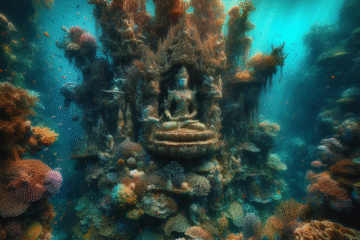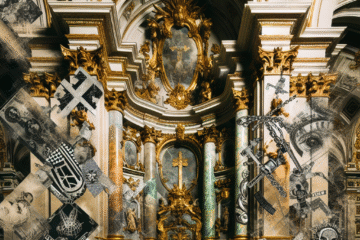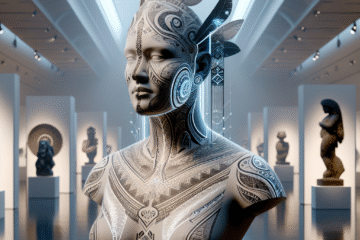Introduction: A Journey Through Realistic Painting Today
Realism in art refers to the depiction of reality as it is, without any idealization or abstraction. It is a style that aims to represent the world as it appears to the senses. Realism in painting can be traced back to the mid-19th century, and it has evolved over the years to embrace new techniques and technologies.
Photorealism and hyperrealism are two forms of realism that have gained popularity in recent times. Photorealism, also known as super-realism, emerged in the late 1960s and was characterized by the use of photographs as a reference for creating highly detailed, accurate depictions of reality. On the other hand, hyperrealism, which developed in the late 20th century, is an advanced form of photorealism that focuses on creating a heightened sense of realism through the use of advanced techniques and technologies.
The purpose of this article is to explore the journey from photorealism to hyperrealism and to examine the evolution of realistic painting. This article will provide a brief history of photorealism, an overview of hyperrealism, and a discussion of the themes and techniques used in realistic painting today.
The aim of this article is to shed light on the importance of realism in contemporary art and to highlight the impact of technology on the evolution of realistic painting. This article will also address the challenges and criticisms faced by realistic painters and provide a glimpse into the future of realistic painting.
Photorealism: A Brief History
Photorealism, also known as super-realism, emerged in the late 1960s and is a form of realism that focuses on creating highly detailed, accurate depictions of reality. The origins of photorealism can be traced back to the pop art movement of the 1950s and 1960s, which celebrated consumer culture and incorporated elements of commercial art into fine art. Photorealism was a response to the abstract expressionist movement and sought to represent the world as it appears to the senses, with a high degree of accuracy and attention to detail.
Characteristics of Photorealism
Photorealism is characterized by the use of photographs as a reference for creating highly detailed, accurate depictions of reality. Photorealistic paintings often feature sharp, precise lines and a smooth, flat surface, which creates a sense of heightened realism. The color palette in photorealistic paintings is usually limited, and the colors are precisely chosen to match the reference photograph. Photorealistic paintings often depict common, everyday objects and scenes, such as automobiles, cityscapes, and still lifes.
Key Figures in Photorealism
Some of the key figures in photorealism include Richard Estes, Chuck Close, Tom Blackwell, Audrey Flack, and Ralph Goings. Richard Estes is considered one of the pioneers of photorealism, and his paintings are characterized by their highly detailed depictions of urban scenes, such as cityscapes and storefronts. Chuck Close is known for his large-scale portraits, which feature photorealistic depictions of faces and bodies. Tom Blackwell is known for his photorealistic paintings of automobiles, and Audrey Flack is known for her photorealistic still lifes. Ralph Goings is another important figure in photorealism, and his paintings feature photorealistic depictions of Americana, such as diners and pickup trucks.
In conclusion, photorealism is a form of realism that emerged in the late 1960s and was characterized by the use of photographs as a reference for creating highly detailed, accurate depictions of reality. Photorealistic paintings often feature sharp, precise lines and a smooth, flat surface, and are characterized by their limited color palette and precise attention to detail. Photorealism was a response to the abstract expressionist movement and sought to represent the world as it appears to the senses.
Hyperrealism: An Evolution of Photorealism
Hyperrealism is an advanced form of photorealism that developed in the late 20th century. Hyperrealism is defined as a form of realism that focuses on creating a heightened sense of reality through the use of advanced techniques and technologies. While photorealism sought to represent the world as it appears to the senses, hyperrealism takes this a step further by incorporating elements of fantasy and illusion to create a sense of heightened reality.
Characteristics of Hyperrealism
Hyperrealistic paintings are characterized by their highly detailed and accurate depictions of reality. However, unlike photorealistic paintings, hyperrealistic paintings often feature elements of fantasy and illusion that create a sense of heightened reality. The surfaces of hyperrealistic paintings are often more textured and expressive, and the colors are more vibrant and intense than those in photorealistic paintings. Hyperrealistic paintings often depict scenes and objects from everyday life, such as cityscapes, portraits, and still lifes.
Differences between Photorealism and Hyperrealism
While both photorealism and hyperrealism are forms of realism, there are some key differences between the two. Photorealism focuses on creating highly detailed, accurate depictions of reality, while hyperrealism takes this a step further by incorporating elements of fantasy and illusion. Photorealistic paintings often feature sharp, precise lines and a smooth, flat surface, while hyperrealistic paintings feature a more textured and expressive surface. The color palette in photorealistic paintings is usually limited and precisely chosen to match the reference photograph, while the colors in hyperrealistic paintings are more vibrant and intense.
In conclusion, hyperrealism is an advanced form of photorealism that focuses on creating a heightened sense of reality through the use of advanced techniques and technologies. Hyperrealistic paintings are characterized by their highly detailed and accurate depictions of reality, but they also incorporate elements of fantasy and illusion to create a sense of heightened reality. Hyperrealism has evolved from photorealism and represents the next step in the evolution of realistic painting.
Themes in Realistic Painting Today
Realistic painting today continues to evolve and be influenced by current events, technology, and the changing landscape of society. Through the use of photorealistic and hyperrealistic techniques, contemporary realistic painters explore a variety of themes that reflect the complexities of modern life and the human condition. Some of the most common themes in realistic painting today include:
A. Reflection of Society
Realistic painting today often reflects the social, political, and cultural issues that are prevalent in society. Contemporary realistic painters use their art to comment on issues such as consumer culture, globalization, and the changing relationship between people and technology. Through their depictions of everyday life, realistic painters bring attention to the complexities and contradictions of modern society, and invite viewers to reflect on the world around them.
B. Exploration of the Human Condition
Realistic painting today often explores the complexities of the human experience, including themes such as identity, emotions, and relationships. Contemporary realistic painters use their art to delve into the human psyche, and to examine the emotions, desires, and fears that are universal to all people. Through their depictions of people and their interactions with the world, realistic painters offer a glimpse into the human experience, and invite viewers to consider the emotional and psychological dimensions of life.
C. Interplay between Reality and Fiction
Realistic painting today often explores the interplay between reality and fiction. Contemporary realistic painters use their art to blur the lines between what is real and what is imagined, and to create works that are both grounded in reality and fantastical. Through their use of photorealistic and hyperrealistic techniques, realistic painters create works that are at once familiar and strange, and that challenge viewers to question the nature of reality.
In conclusion, realistic painting today continues to evolve and be influenced by current events and the changing landscape of society. Through the use of photorealistic and hyperrealistic techniques, contemporary realistic painters explore a variety of themes that reflect the complexities of modern life and the human condition. Whether they are reflecting society, exploring the human condition, or blurring the lines between reality and fiction, realistic painters today are producing works that are both relevant and thought-provoking.
Techniques and Tools in Realistic Painting
Realistic painting is a complex and demanding art form that requires a combination of traditional techniques and the latest technological tools. In order to create highly detailed and accurate depictions of reality, realistic painters must master a variety of techniques and tools, both old and new. Some of the most important techniques and tools in realistic painting today include:
A. Traditional Painting Techniques
Realistic painters have used traditional painting techniques for centuries to create lifelike depictions of reality. Some of the most important traditional techniques in realistic painting include the use of oils, acrylics, and watercolors. These mediums allow painters to build up multiple layers of color and texture, creating a rich and detailed surface. In addition to traditional mediums, realistic painters also use techniques such as blending, layering, and glazing to create highly detailed and accurate depictions of reality.
B. Advancements in Technology and Digital Tools
In recent years, advancements in technology and digital tools have revolutionized the field of realistic painting. Digital tools such as computer software, tablets, and 3D modeling programs allow realistic painters to create highly detailed and accurate depictions of reality with greater speed and efficiency. By using digital tools, painters can manipulate images and create highly detailed renderings of objects, people, and landscapes. In addition, digital tools allow painters to create works that would otherwise be impossible with traditional techniques.
C. Integration of Traditional and Digital Techniques
Realistic painters today often use a combination of traditional and digital techniques to create their works. This integration of traditional and digital techniques allows painters to take advantage of the best of both worlds, using traditional techniques to create the look and feel of traditional paintings, and digital tools to enhance the accuracy and detail of their works. By combining these techniques, realistic painters are able to create works that are both highly realistic and deeply personal, reflecting the unique vision and style of the artist.
In conclusion, realistic painting is a complex and demanding art form that requires a combination of traditional techniques and the latest technological tools. By using traditional painting techniques, digital tools, and the integration of traditional and digital techniques, realistic painters are able to create works that are both highly detailed and accurate depictions of reality. Whether they are working with traditional mediums or the latest digital tools, realistic painters today are producing works that are both beautiful and thought-provoking.
Challenges and Criticisms of Realistic Painting
Realistic painting is a complex and demanding art form that has faced many challenges and criticisms over the years. Despite its popularity and the skill required to create highly realistic works, realism has often been criticized as lacking in originality and creativity, and some see it as a less legitimate form of art compared to other styles. At the same time, realistic painters face a variety of challenges in creating their works, from technical difficulties to the pressure of maintaining high standards of accuracy and detail. In this section, we will explore some of the challenges and criticisms that realistic painting has faced over the years, and consider the response of the art community to these issues.
A. Criticisms of Realism as a Form of Art
Realistic painting has often been criticized for lacking in originality and creativity, and some see it as a less legitimate form of art compared to other styles. Critics argue that realistic painters simply copy reality, rather than creating something new and unique. Some also argue that realistic painting is too focused on technical skill and accuracy, at the expense of emotional impact and artistic expression.
B. Challenges Faced by Realistic Painters
Realistic painters face a variety of challenges in creating their works, from technical difficulties to the pressure of maintaining high standards of accuracy and detail. Creating a highly realistic work of art requires a deep understanding of anatomy, perspective, and the science of light and shadow, as well as a mastery of technical skills and techniques. At the same time, realistic painters must constantly strive to maintain the highest standards of accuracy and detail, making it a demanding and challenging form of art.
C. Response of the Art Community to Realism
Despite the criticisms and challenges faced by realistic painters, realism remains an important and highly respected form of art. Many artists and art lovers appreciate the technical skill and accuracy required to create realistic works, as well as the beauty and emotional impact of highly detailed depictions of reality. Realistic paintings continue to be displayed in galleries and museums, and many artists continue to produce highly realistic works today, reflecting the changing world around them and the human condition.
In conclusion, realistic painting continues to face challenges and criticisms, from accusations of lacking in originality and creativity to the technical difficulties and high standards of accuracy and detail. At the same time, many artists and art lovers continue to appreciate the beauty and emotional impact of realistic painting, and the art form remains an important and highly respected form of art. Whether viewed as a challenge or a source of inspiration, realism continues to play an important role in the world of art today.
Conclusion
In this article, we have explored the journey from photorealism to hyperrealism, and considered the importance of realism in contemporary art. We have considered the origins and evolution of photorealism and hyperrealism, the themes and techniques used in realistic painting today, and the challenges and criticisms faced by realistic painters. In this final section, we will recap the journey from photorealism to hyperrealism, and consider the importance of realism in contemporary art, before offering some final thoughts and a look at the future outlook for realistic painting.
A. Recap of the Journey from Photorealism to Hyperrealism
Photorealism emerged in the 1960s and 1970s as a response to the abstract and expressionist art movements of the time. Photorealists sought to create highly accurate and detailed depictions of reality, using photographs as reference and often working in series to explore a particular subject or theme. Over time, photorealism evolved into hyperrealism, a style that pushed the boundaries of realism even further, incorporating elements of photorealism with a heightened focus on detail and technical skill.
B. Importance of Realism in Contemporary Art
Realism continues to play an important role in contemporary art, reflecting the changing world around us and the human condition. Whether it is through the highly accurate and detailed depictions of photorealism or the heightened realism of hyperrealism, realism offers a window into the world, allowing us to consider the complexities of reality and our place within it. Realistic painting is also an important form of artistic expression, requiring technical skill and mastery of techniques, as well as a deep understanding of the world around us.
C. Final Thoughts and Future Outlook for Realistic Painting
Realistic painting will continue to evolve and change over time, responding to new technological advances, changes in society, and shifting artistic tastes. Whether viewed as a challenge or a source of inspiration, realism remains an important and highly respected form of art, offering us a window into the world and reflecting the complexities of reality and the human condition. Whether you are an artist or an art lover, realism will continue to be an important and fascinating part of the art world for many years to come.
In conclusion, the journey from photorealism to hyperrealism is a testament to the ongoing evolution of realistic painting, and the importance of realism in contemporary art. Whether exploring the complexities of reality or pushing the boundaries of realism even further, realistic painting continues to be an important and highly respected form of art, offering a window into the world and reflecting the complexities of the human condition. Whether viewed as a challenge or a source of inspiration, realism will continue to play an important role in the art world for many years to come.


